Do you have a question about the KYMCO X-Town 300 and is the answer not in the manual?
Essential safety guidelines and practices for riding the scooter.
Guidelines on using and installing accessories and avoiding vehicle modifications.
Visual identification and labeling of key parts and controls on the scooter.
Explanation of the ignition switch positions and their functions.
Instructions on how to operate the ignition switch security shutter.
Description of dashboard indicators, meters, and warning lights.
Details on starter, engine stop, and hazard switches.
Explanation of turn signal, horn, dimmer, and passing switches.
How to check fuel level and refuel the scooter.
Procedures for unlocking, locking, and using the seat and helmet holder.
Adjustment of rear shock absorber spring preload.
Functionality and inspection of the side stand safety interlock.
Essential checks to perform on the scooter before riding.
Guidelines for proper break-in operation for vehicle longevity.
Step-by-step instructions for safely starting the engine.
Explanation of the Anti-lock Braking System and its functionality.
Why regular maintenance is crucial for safety, economy, and performance.
Overview and chart for scheduled maintenance intervals and tasks.
Recommendations and procedures for engine oil, including level check and replacement.
Steps for changing the transmission gear oil.
Cleaning, gap adjustment, and replacement of the spark plug.
Procedure for checking and replacing brake fluid.
Inspecting brake pads for wear and determining replacement needs.
Information about the sealed battery type and its maintenance.
Importance of tire pressure, condition, and replacement.
How to check coolant level and recommendations for replacement.
Steps to take when taking the scooter out of storage.
How the crankcase blow-by gas is managed.
How exhaust emissions are controlled, including the catalytic converter.
System to prevent gasoline vapor escape.
Compliance with noise regulations for engine, intake, and exhaust systems.
Physical measurements of the scooter.
Fluid capacities for engine oil, transmission oil, and fuel tank.
Technical specifications of the engine.
Chassis-related specifications like tire size and brakes.
Electrical system specifications, including ignition, battery, and lights.
Essential safety guidelines and practices for riding the scooter.
Guidelines on using and installing accessories and avoiding vehicle modifications.
Visual identification and labeling of key parts and controls on the scooter.
Explanation of the ignition switch positions and their functions.
Instructions on how to operate the ignition switch security shutter.
Description of dashboard indicators, meters, and warning lights.
Details on starter, engine stop, and hazard switches.
Explanation of turn signal, horn, dimmer, and passing switches.
How to check fuel level and refuel the scooter.
Procedures for unlocking, locking, and using the seat and helmet holder.
Adjustment of rear shock absorber spring preload.
Functionality and inspection of the side stand safety interlock.
Essential checks to perform on the scooter before riding.
Guidelines for proper break-in operation for vehicle longevity.
Step-by-step instructions for safely starting the engine.
Explanation of the Anti-lock Braking System and its functionality.
Why regular maintenance is crucial for safety, economy, and performance.
Overview and chart for scheduled maintenance intervals and tasks.
Recommendations and procedures for engine oil, including level check and replacement.
Steps for changing the transmission gear oil.
Cleaning, gap adjustment, and replacement of the spark plug.
Procedure for checking and replacing brake fluid.
Inspecting brake pads for wear and determining replacement needs.
Information about the sealed battery type and its maintenance.
Importance of tire pressure, condition, and replacement.
How to check coolant level and recommendations for replacement.
Steps to take when taking the scooter out of storage.
How the crankcase blow-by gas is managed.
How exhaust emissions are controlled, including the catalytic converter.
System to prevent gasoline vapor escape.
Compliance with noise regulations for engine, intake, and exhaust systems.
Physical measurements of the scooter.
Fluid capacities for engine oil, transmission oil, and fuel tank.
Technical specifications of the engine.
Chassis-related specifications like tire size and brakes.
Electrical system specifications, including ignition, battery, and lights.
| Cooling System | Liquid cooled |
|---|---|
| Maximum Torque | 22.5 Nm @ 6500 rpm |
| Transmission | CVT |
| Front Suspension | Telescopic fork |
| Rear Suspension | Dual shocks |
| Front Brake | Disc |
| Rear Brake | Disc |
| Front Tire | 120/70-15 |
| Seat Height | 800 mm |
| Width | 800 mm |
| Fuel Capacity | 12.5 Liters |
| Engine Type | 4-stroke, single cylinder |
| Fuel System | Electronic Fuel Injection |
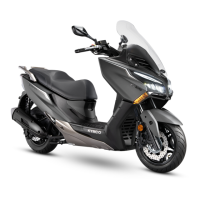

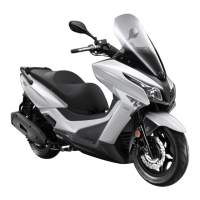
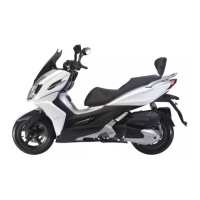
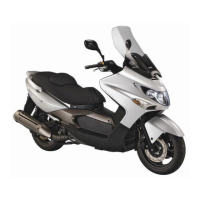
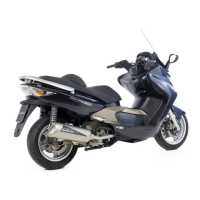
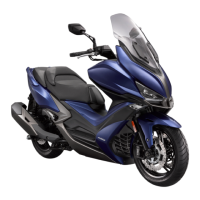
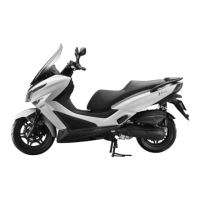

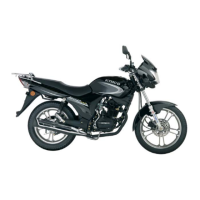
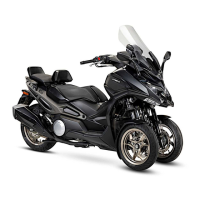
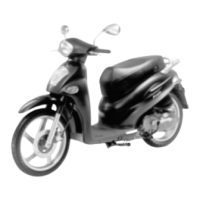
